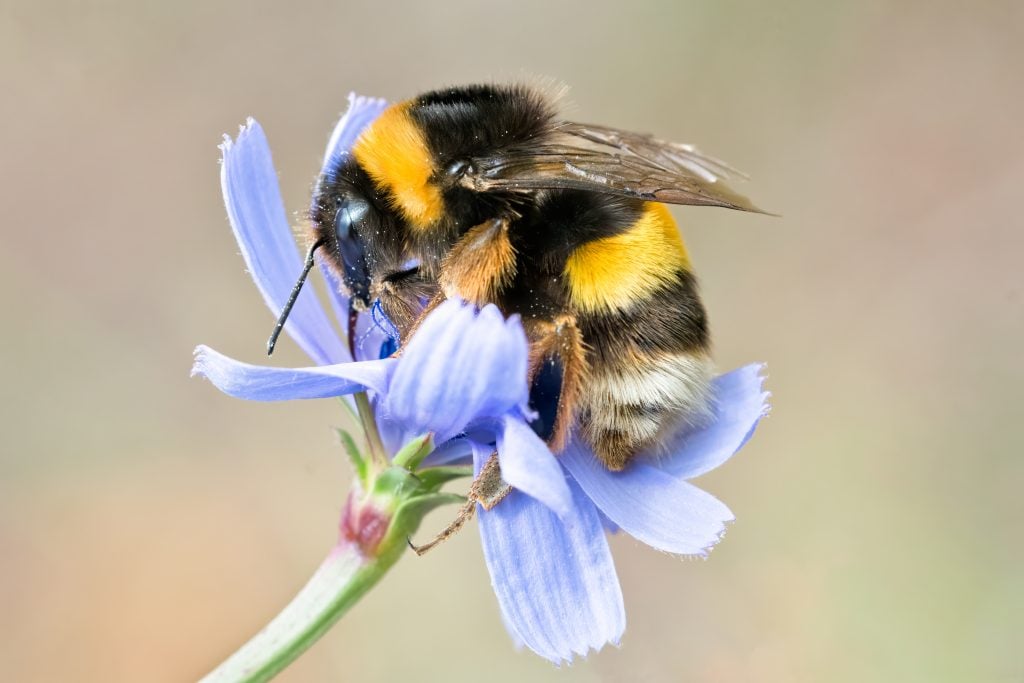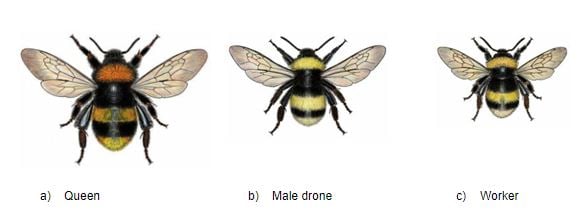
Bumblebee on blue wild flower
Bumblebees are large, hairy, social bees belonging to the family Apidae (subfamily Bombinae). Bumblebees are not known to occur on mainland Australia, however, the large earth bumblebee, Bombus terrestris, has established in Tasmania. Several species of bumblebees, including the large earth bumblebee, are established in New Zealand.
There have been occasional reports of bumblebees in Victoria, however none of these have been confirmed.
Do bumblebees look different to other bees?

Figure 1: Large Earth Bumblebee Bombus terrestris
(Collection: Tasmanian Museum and Art Gallery)

Figure 2: Common Bees, Wasps and Flies in your Garden
(Collection: Tasmanian Museum and Art Gallery)
The simple answer is yes, although many native bees occur in Australia, none resemble bumblebees. The large earth bumblebee is hairier, and more heavily built, than the European honeybee or the European wasp. It is black with one yellow/ochre band across the front of the thorax, and another yellow/ochre band across the abdomen. An important identifying feature is the tip of the abdomen, which is a distinctive buff or white.
Large earth bumblebee queens are 30-35 mm in length and make a very noticeable buzzing sound during flight. Males are approximately 22 mm in length whilst workers are highly variable in size, ranging from 8 mm to 22 mm in length. In comparison, European honeybee (Apis mellifera) workers are approximately 15 mm long and are dark yellow-orange and black.
European wasp (Vespula germanica) workers average around 15 mm long, and European wasp queens can be up to 20 mm long. European wasps are bright yellow and black, and less hairy than bumblebees or honeybees.
Should you be worried?
Though bumblebees can sting, they will generally only do so when physically threatened, so do not pose a significant health concern.
The primary concern is to our environment and our primary production. In Victoria, the “introduction and spread of the large earth bumblebee (Bombus terrestris) into Victorian terrestrial environments” has been listed as a potentially threatening process under the Victorian Flora and Fauna Guarantee Act 1988. Potential impacts include:
- Competition with and displacement of native nectar feeding fauna,
- Decline in the seed production of native plant species,
- Increase in the seed production of introduced plants for which the large earth bumblebee are an efficient pollinator, which makes them more invasive weeds. The large earth bumblebee is such an efficient pollinator it is used commercially overseas to pollinate certain glasshouse and field crops.
Check your plants!
Mild, sunny mornings are ideal to check for signs of the bumblebee in your plants. If you think you have seen a bumblebee, please call the Exotic Plant Pest Hotline on 1800 084 881. You’ll be directed to the relevant Government Department
Alternatively, take a photo and upload any unusual bees that you see in your garden to the MyPestGuide Reporter website or app. If you live in Victoria, your report will go directly to Agriculture Victoria’s team of entomologists.
With your help, we can keep bumblebees out of Victoria.
Warning: Bumblebees can sting. Do not handle live bees. Only collect bumblebees if you are competent in the collection of stinging insects and it is safe to do so.
What are we doing?
In Victoria, Agriculture Victoria’s team of entomologists and biosecurity staff respond to all reports of bumblebee sightings and specimens. Agriculture Victoria is currently undertaking a floral sweep netting in Melbourne to check for bumblebees.
In Victoria, the Department of Environment, Land, Water and Planning is preparing an Action Statement that describes the threat, and states what will be done to manage the threat. There are a number of websites with information on various species of bumblebees:
Information on bumblebees and what do do if you suspect you spot one can be obtained from:
- Agriculture Victoria
- Large Earth Bumblebee – Business Queensland
- Bumblebees – NSW DPI
- Invasive Bees – Australian Department of Agriculture and Water and Environment
- Bumblebee -DPIRD WA
Information on bumblebees in Tasmania can be obtained from Tasmanian Museum and Art Gallery.
Don’t forget to check out our Pest Warrior comic and fill in our Target Pest Activity Book.
